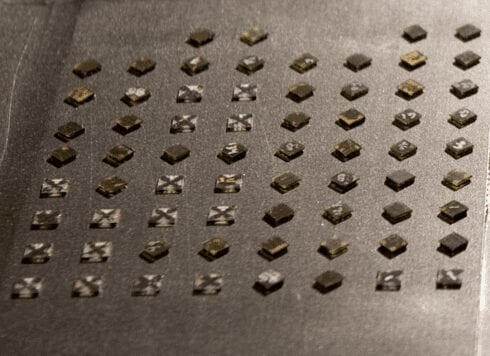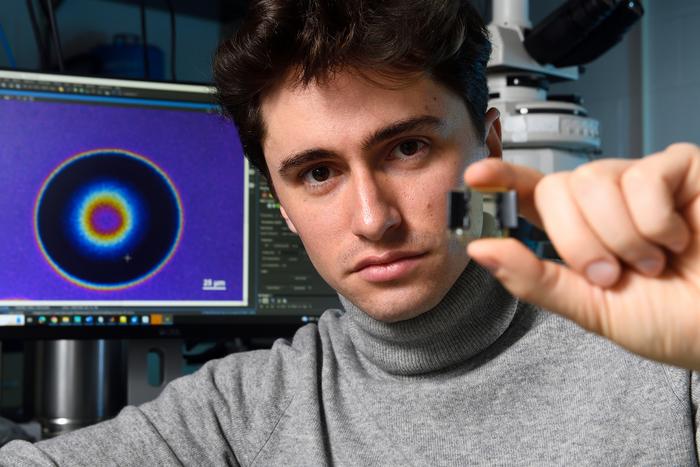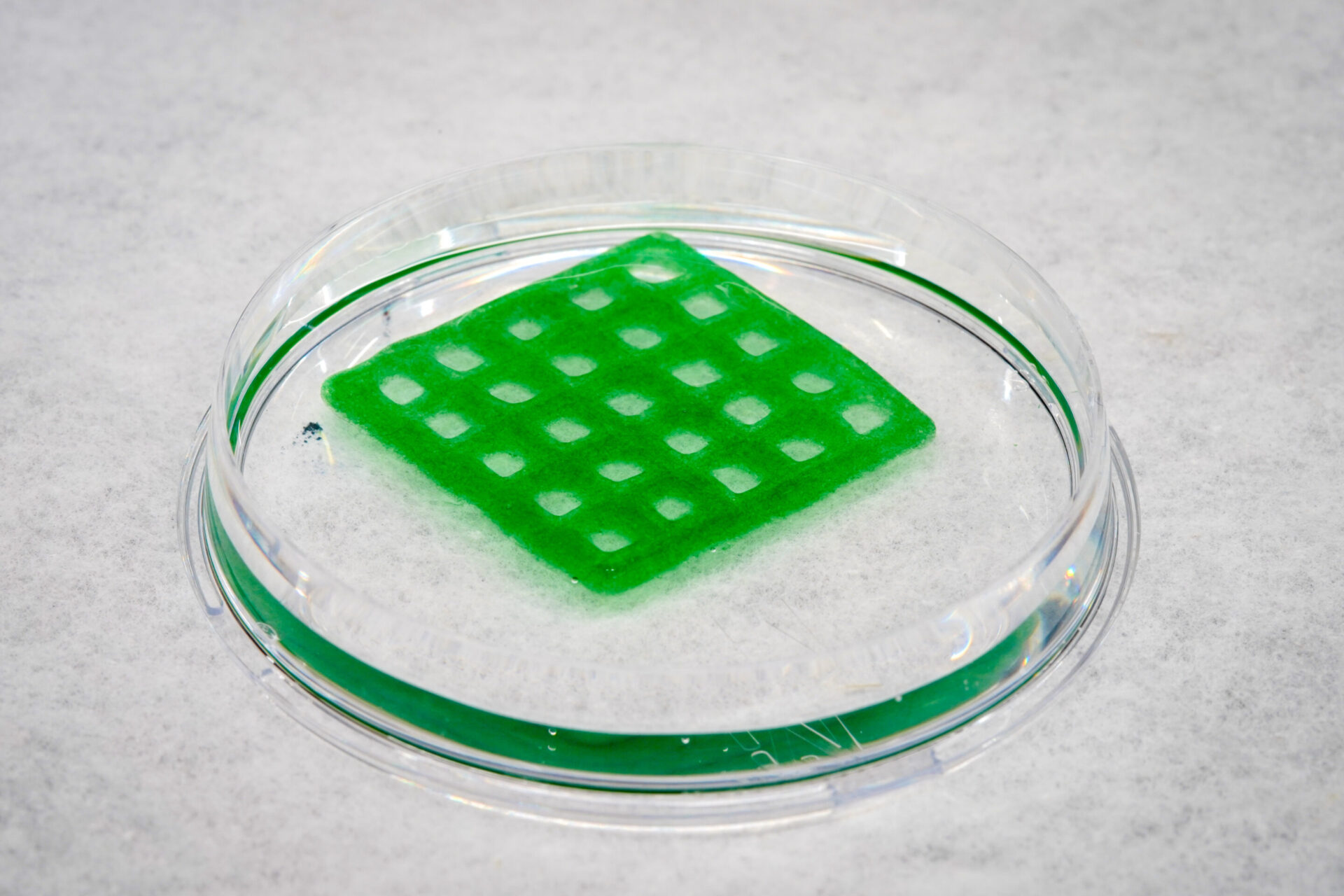
The dye rhodamine-B gives the microrobot its orange colour. Its intensity provides information about how warm it is.
Astrid Eckert / TUM
Opportunities for cancer treatment and wound healing
A group of researchers at the Technical University of Munich (TUM) has developed the world’s first microrobot (“microbot”) capable of navigating within groups of cells and stimulating individual cells. Berna Özkale Edelmann, a professor of Nano- and Microrobotics, sees potential for new treatments of human diseases.
They are round, half as thick as a human hair, contain gold nanorods and fluorescent dye, and are surrounded by a biomaterial obtained from algae. They can be driven by laser light to move between cells. These tiny robots were invented by Prof. Berna Özkale Edelmann. To be exact, the bioengineer and director of the Microrobotic Bioengineering Lab has worked with her team of researchers to develop a technological platform for the large-scale production of these vehicles. They are currently being used in vitro, outside the human body.
Minirobots: a taxi ride to the cell
The TACSI microbots differ from classical humanoid robots or robotic arms as seen in factories. The entire system requires a microscope to enlarge the small-scale worlds, a computer and a laser to drive the 30-micrometer (µm), human-controlled microbots. Another special aspect: not only can the robots be heated. They also continually indicate their temperature. This is important because, along with the ability to find their way to individual cells, they are also designed to heat the locations of individual cells or cell groups.
TACSI stands for Thermally Activated Cell-Signal Imaging. In simple terms, it is an image-based system that is capable of heating cells in order to activate them. TACSI is a “taxi” in every sense of the word: in the future, the tiny robot will “drive” directly to the location where researchers wish to study cellular processes. “In a worldwide first, we have developed a system that not only enables microbots to navigate through groups of cells. It can even stimulate individual cells through temperature changes,” says Prof. Özkale Edelmann.
How are microbots made?
The production of microbots is based on ‘microfluidic chips’ that model the manufacturing process. Biomaterial is injected through a channel on the left-hand side of the chip. An oil with specific components is then added from above and below through 15–60 µm channels. The finished robots emerge on the right. In the case of the TACSI microbot, the following components are added:
- A fluorescent dye: in this case the orange rhodamine B dye is used that loses color intensity with increasing temperature. This makes the microbot an effective thermometer for the observer.
- Gold nanorods: the 25–90 nanometer (nm) precious metal rods have the property of heating rapidly (and cooling down again) when bombarded with laser light. It takes only a few microseconds to raise the temperature of the robot by 5°C. The nanorods can be heated to 60°C. Through the automatic temperature balancing process of the nanorods (known as convection), the robots are set in motion at a maximum speed of 65 µm per second.
“This makes it possible to make up to 10,000 microbots in a single production run,” explains Philipp Harder, a member of the research team.
Cells respond to temperature changes
Small temperature changes are sometimes enough to influence cell processes. “When the skin is injured, for example through a cut, the body temperature rises slightly, causing the immune system to be activated,” explains Prof. Özkale Edelmann. She wants to learn more about whether this “thermal stimulation” can be used to heal wounds. There is also a lack of research on whether cancer cells become more aggressive when stimulated. Current studies show that cancer cells die off at high temperatures (60°C). This effect can also be used to treat heart arrhythmia and depression.
Calcium import: ion channels in cells opened
Researchers in Prof. Özkale Edelmann’s team used kidney cells to demonstrate that cellular ion channels can be influenced. To do this, they steered the TACSI microbots to the cells. “We used the infrared laser to raise the temperature. To measure the increase, we measured the intensity of the rhodamine B dye color” explains Philipp Harder. The team observed that the ion channels of the cells opened at certain temperatures, for example to allow calcium to enter the cell. “Using this concrete example, we showed that heat causes changes in the cell, even with slight temperature increases,” says Prof. Özkale Edelmann. She hopes that further research will point the way to new treatments – for example by making it possible to channel drugs into individual cells.
Original Article: Microrobots for the study of cells
More from: Technical University of Munich
The Latest Updates from Bing News
Go deeper with Bing News on:
Microbot
- Microbot Medical Inc MBOT
We sell different types of products and services to both investment professionals and individual investors. These products and services are usually sold through license agreements or subscriptions ...
- Microbot Medical Inc MBOT
Morningstar Quantitative Ratings for Stocks are generated using an algorithm that compares companies that are not under analyst coverage to peer companies that do receive analyst-driven ratings ...
- Microbot Medical Inc. (MBOT)
April 29, 2024 (GLOBE NEWSWIRE) -- Microbot Medical Inc. (Nasdaq: MBOT), developer of the innovative LIBERTY® Endovascular Robotic Surgical System, today reports that the first phase of the ...
- Microbot Medical Announces Positive Results from the First Phase of its Collaboration with ...
Microbot Medical Inc. (Nasdaq: MBOT), developer of the innovative LIBERTY® Endovascular Robotic Surgical System, today reports that the first phase of the ...
- Microbot Medical Announces Positive Results from the First Phase of its Collaboration with Corewell Health™
BRAINTREE, Mass., April 29, 2024 (GLOBE NEWSWIRE) -- Microbot Medical Inc. (Nasdaq: MBOT), developer of the innovative LIBERTY® Endovascular Robotic Surgical System, today reports that the first phase ...
Go deeper with Bing News on:
TACSI microbots
- Reuters Video
Reuters, the news and media division of Thomson Reuters, is the world’s largest multimedia news provider, reaching billions of people worldwide every day. Reuters provides business, financial ...
- Medical Moment: The future of medical microbots
They’re called microbots, also known as nanobots. They’re microscopic in scale, and thousands of them could be delivered by swallowing a single pill. They could one day deliver life-saving ...
- Health Beat: The future of medical microbots
They’re called microbots, also known as nanorobots. Microscopic in scale, experts say thousands of them could be delivered by swallowing a single pill. They could one day deliver life-saving ...
- Here are the future of medical microbots
If you need help with the Public File, call (313) 222-0556. At WDIV, we are committed to informing and delighting our audience. In our commitment to covering our communities with innovation and ...
- Nanobots to the Rescue! The Future of Medical Microbots
They’re called microbots, also known as nanorobots. They’re microscopic in scale and thousands of them could be delivered by swallowing a single pill. They could one day deliver life-saving ...











